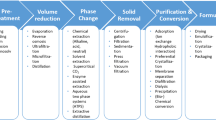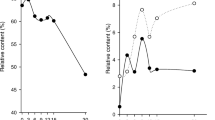Abstract
The precondition of studying biological sample is to extract sample metabolites by the best pretreatment methods. There is already limited information about pretreatments of fermented feed metabolites. The study compared the extraction effects of different pulverisation methods used in the sample pretreatment process for the extraction of metabolites from cottonseed meal fermented by Lactobacillus acidophilus based on UPLC-Q-TOF-MS. The extraction effects of three pretreatments (non-pulverisation (WF), pulverisation (F), and high-speed homogenisation methods (YJ)) were compared with the numbers of metabolites and the normalised peak areas of the metabolites. The results showed that the number of metabolites extracted with three pulverisation methods were 1745, 1896, 2132 (ESI+ mode) and 1447, 1675, 2073 (ESI− mode), respectively. The number of variable importance plot (VIP) metabolites and the relative peak areas of metabolites showed that the trend was YJ > F > WF. The extraction effect of high-speed homogenisation method was the best way to extract metabolites from the fermented cottonseed meal. This study built a foundation work for the further research of the fermented feed metabolomics.


Similar content being viewed by others
References
Bujak R, Struck-Lewicka W, Markuszewski MJ, Kaliszan R (2015) Metabolomics for laboratory diagnostics. J Pharm Biomed Anal 113:108–120
Liu X, Locasale JW (2017) Metabolomics: a primer. Trends Biochem Sci 42(4):274. https://doi.org/10.1016/j.tibs.2017.01.004
Raterink R-J, Lindenburg PW, Vreeken RJ, Ramautar R, Hankemeier T (2014) Recent developments in sample-pretreatment techniques for mass spectrometry-based metabolomics. Trac-Trend Anal Chem 61:157–167
Schaub J, Schiesling C, Reuss M (2006) Dauner M (2006) Integrated sampling procedure for metabolome analysis. Biotechnol Progr 22(5):1434–1442
Maharjan RP, Ferenci T (2003) Global metabolite analysis: the influence of extraction methodology on metabolome profiles of Escherichia coli. Anal Biochem 313(1):145–154
Rabinowitz JD, Kimball E (2007) Acidic acetonitrile for cellular metabolomeextraction from Escherichia coli. Anal Chem 79(16):6167–6173
Winder CL, Dunn WB, Schule S, Broadhurst D, Jarvis R, Stephens GM, Goodacre R (2008) Global metabolic profiling of escherichia coli cultures: an evaluation of methods for quenching and extraction of intracellular metabolites. Anal Chem 80(8):2939
Faijes M, Mars AE, Smid EJ (2007) Comparison of quenching and extraction methodologies for metabolome analysis of lactobacillus plantarum. Microb Cell Fact 6(1):27–27
Chen MM, Li AL, Sun MC, Feng Z, Meng XC, Wang Y (2014) Optimization of the quenching method for metabolomics analysis oflactobacillus bulgaricus. J Zhejiang Univ-SC B 15(4):333–342
Tokuoka M, Sawamura N, Kobayashi K, Mizuno A (2010) Simple metabolite extraction method for metabolic profiling of the solid-state fermentation of aspergillus oryzae. J Biosci Bioeng 110(6):665–669
Dettmer K, Nadine N, Kaspar H, Gruber MA, Almstetter MF, Oefner PJ (2011) Metabolite extraction from adherently growing mammalian cells for metabolomics studies: optimization of harvesting and extraction protocols. Anal Bioanal Chem 399(3):1127–1139
Fraga CG, Clowers BH, Moore RJ, Zink EM (2010) Signature-discovery approach for sample matching of a nerve-agent precursor using liquid chromatography-mass spectrometry, xcms, and chemometrics. Anal Chem 82(10):4165–4173
Wu N, Clausen AM (2007) Fundamental and practical aspects of ultrahigh pressure liquid chromatography for fast separations. J Sep Sci 30(8):1167–1182
Sana TR, Fischer S, Wohlgemuth G, Katrekar A, Jung KH, Ronald PC (2010) Metabolomic and transcriptomic analysis of the rice response to the bacterial blight pathogenxanthomonas oryzaepv.oryzae. Metabolomics 6(3):451–465
Badran M, Morsy R, Soliman H, Elnimr T (2015) Assessment of trace elements levels in patients with Type 2 diabetes using multivariate statistical analysis. J Trace Elem Med Bio 33:114–119
Zhao YY, Cheng XL, Cui JH, Yan XR, Wei F, Bai X, Lin RC (2012) Effect of ergosta-4,6,8(14),22-tetraen-3-one (ergone) on adenine-induced chronic renal failure rat: a serum metabonomic study based on ultra performance liquid chromatography/high-sensitivity mass spectrometry coupled with masslynx i-fit algorithm. Clin Chim Acta 413(19–20):1438–1445
Zhu ZJ, Schultz AW, Wang J, Johnson CH, Yannone SM, Patti GJ, Siuzdak G (2013) Liquid chromatography quadrupole time-of-flight mass spectrometry characterization of metabolites guided by the metlin database. Nat Protoc 8(3):451–460
Guijas C, Montenegro-Burke JR, Domingo-Almenara X, Palermo A, Warth B, Hermann G, Koellensperger G, Huan T, Uritboonthai W, Aisporna AE, Wolan DW, Spilker ME, Benton HP, Siuzdak G (2018) METLIN: a technology platform for identifying knowns and unknowns. Anal Chem 90(5):3156–3164
Vorkas PA, Isaac G, Anwar MA, Davies AH, Want EJ, Nicholson JK, Holmes E (2015) Untargeted uplc-ms profiling pipeline to expand tissue metabolome coverage: application to cardiovascular disease. Anal Chem 87(8):4184–4193
Li Y, Peng Y, Wang M, Zhou G, Zhang Y, Li X (2016) Rapid screening and identification of the differences between metabolites of Cistanche deserticola and C. tubulosa water extract in rats by UPLC-Q-TOF-MS combined pattern recognition analysis. J Pharm Biomed 131:364–372
Want EJ (2018) LC-MS untargeted analysis method. Mol Biol 1738:99
Raterink RJ, Lindenburg PW, Vreeken RJ, Ramautar R, Hankemeier T (2014) Recent developments in sample-pretreatment techniques for mass spectrometry-based metabolomics. TrAC Trends Anal Chem 61:157–167
Acknowledgements
This study was financially supported by the Science and Technology Research Project of Henan province (No.192102110071), the Program for Innovative Research Team (No.20IRTSTHN025), and the Key Scientific Research Projects of Institutions of Higher Learning in Henan province (No.19B230006). We would like to thank Suzhou BioNovoGene (https://www.bionovogene.com) for technical supports in the comprehensive analysis of the MS/MS data.
Author information
Authors and Affiliations
Corresponding authors
Ethics declarations
Conflict of interest
The authors indicate no potential conflicts of interest.
Additional information
Publisher's Note
Springer Nature remains neutral with regard to jurisdictional claims in published maps and institutional affiliations.
Rights and permissions
About this article
Cite this article
Wang, Y., Xie, H., Liu, D. et al. Effects of Different Sample Pulverisation Methods on the Extraction of Metabolites from the Fermented Cottonseed Meal Based on UPLC-Q-TOF-MS. Curr Microbiol 77, 2751–2757 (2020). https://doi.org/10.1007/s00284-020-02057-5
Received:
Accepted:
Published:
Issue Date:
DOI: https://doi.org/10.1007/s00284-020-02057-5




